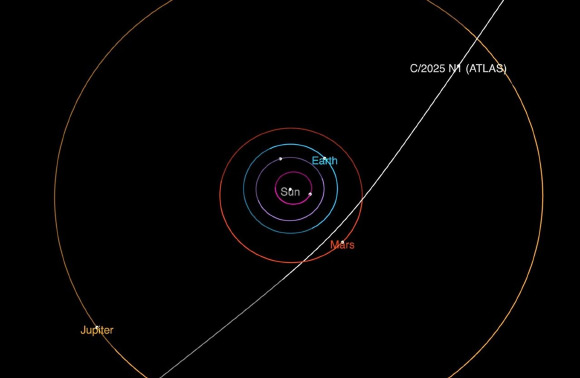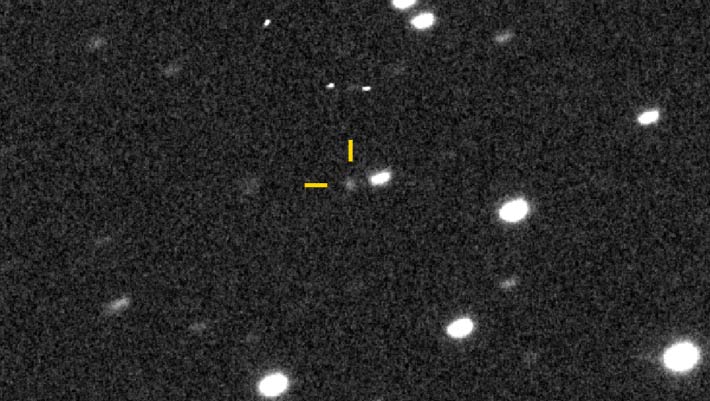After the interstellar asteroid 1I/ʻOumuamua and the interstellar comet 2I/Borisov, 3I/ATLAS is the third object and the second comet from outside the Solar System confirmed.
This image, taken with the iTelescope.Net T72 telescope at Rio Hurtado, Chile, on July 2, 2025, shows the interstellar comet 3I/ATLAS. Image credit: Filipp Romanov / CC BY-SA 4.0.
3I/ATLAS was discovered by the NASA-funded ATLAS (Asteroid Terrestrial-impact Last Alert System) survey telescope in Rio Hurtado, Chile, on July 1, 2025.
Arriving from the direction of the constellation Sagittarius, the interstellar comet is currently located about 670 million km (420 million miles) away.
“Since that first report, observations from before the discovery have been gathered from the archives of three different ATLAS telescopes around the world and the Zwicky Transient Facility at the Palomar Observatory in San Diego County, California,” NASA astronomers wrote in a statement.
“These ‘pre-discovery’ observations extend back to June 14, 2025.”
Also known as C/2025 N1 (ATLAS) and A11pl3Z, 3I/ATLAS is currently about 4.5 AU (670 million km, or 416 million miles) from the Sun.
The comet poses no threat to Earth and will remain at a distance of at least 1.6 AU (240 million km, or 150 million miles).
It will reach its closest approach to the Sun around October 30, 2025, at a distance of 1.4 AU (210 million km, or 130 million miles) — just inside the orbit of Mars.
Its size and physical properties are being investigated by astronomers around the world.

This diagram shows the trajectory of 3I/ATLAS as it passes through the Solar System. Image credit: NASA / JPL-Caltech.
“If 3I/ATLAS’s brightness stems from reflecting sunlight at the typical albedo of order 10%, then its diameter of 20 km is about 100-200 times larger than the estimated length of ‘Oumuamua (and over a thousand times larger than ‘Oumuamua’s width) and about 50-100 times larger than the core of the comet Borisov,” Professor Avi Loeb, the head of the Galileo Project, founding director of Harvard University’s Black Hole Initiative, and director of the Institute for Theory and Computation at the Harvard-Smithsonian Center for Astrophysics, wrote in his blog.
“If all three objects are rocks, then 3I/ATLAS’s mass is over ten million times larger than that of ‘Oumumua and at least a hundred thousand times larger than the core mass of Borisov.”
“This is surprising because one expects high mass objects to be much rarer.”
“Based on data about the main asteroid belt in the Solar System, one would expect millions of objects like ‘Oumuamua for each object on the mass scale of 3I/ATLAS.”
3I/ATLAS should remain visible to ground-based telescopes through September 2025, after which it will pass too close to the Sun to observe.
It is expected to reappear on the other side of the Sun by early December, allowing for renewed observations.
“Based on its direction of motion, 3I/ATLAS appears to be coming at a retrograde orbit with an inclination of 175 degrees relative to the Earth’s orbital plane from the thin disk of stars in the Milky Way Galaxy,” Professor Loeb wrote.
“In the coming months, we will learn much more about 3I/ATLAS’s properties based on data from multiple ground-based telescopes including the NSF/DoE Vera C. Rubin Observatory in Chile, as well as possibly from the NASA/ESA/CSA James Webb Space Telescope.”
